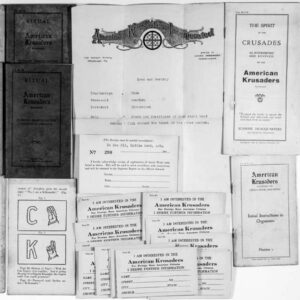calsfoundation@cals.org
American Krusaders
The American Krusaders was an organization founded in 1923 that claimed Little Rock (Pulaski County) as its “supreme headquarters.” The group’s application for incorporation was filed in the district court in Little Rock on August 27, 1923, and the petition seeking incorporation said that the organization would be run by a national legislative body called the National Konvention of the American Krusaders.
While the Krusaders’ charter described the organization as “purely benevolent, charitable fraternal, protective and eleemosynary,” it was regularly described as an offshoot or affiliate of the Ku Klux Klan (KKK). The New York Daily News referred to it as a “Klan chapter for the foreign born,” while the Camden, New Jersey, Courier-Post observed that its members, while “mostly of foreign birth or of foreign extraction one generation back…joined the new organization for exactly the same reasons as their native brethren joined the Klan.” But, ironically, William Joseph Simmons, the founder of the revitalized 1920s version of the Ku Klux Klan, disputed those claims, alleging that the Krusaders were, in fact, founded as a competitor of his organization. In addition to the many reports linking the two organizations, the fact that the incorporation papers for the American Krusaders were filed by James A. Comer, Grand Dragon of the Realm of Arkansas and Exalted Cyclops of Little Rock Klan No. 1, Knights of the Ku Klux Klan—as well as Fred L. Gifford, the Grand Dragon of Oregon; H. C. McCall, the Grand Dragon of Texas; and Martin W. Rose of Seattle, a naturalized American citizen originally born in Canada—did much to refute Simmons’s charge.
In fact, however, there were differences between the Klan and the Krusaders, despite apparently sharing some members. The early efforts of Rose, who had previously founded (although not incorporated) a Klan-like organization called the Royal Riders of the Red Robe—a group whose only difference from the Klan seemed to be their scarlet gowns—reflected one major difference, since as a naturalized citizen, even if from the United States’ northern neighbor, Rose was not eligible for membership in the parent organization. In fact, the overlap stemmed at least in part from the Krusaders’ pursuit of so-called upright white Americans who could “help make better Americans of naturalized Foreign born” Americans, a sentiment expressed in a newspaper advertisement that urged people to “JOIN This Movement Endorsed by the K.K.K.”
Unlike the Klan, the Krusaders made clear that their organization was founded at least in part to provide a place for immigrants. The Krusaders willingly took in foreign-born individuals who were not allowed into the KKK, although this level of openness had its limits, as the Krusaders pointedly excluded from their membership immigrants from Greece, Italy, and the Balkans regardless of their religion. Some observers maintained that the semi-open door was a response to the limits on the income that could be generated from the slowly growing native-born white population.
The group was headquartered in Little Rock, and it was there that it issued its “ritual” in 1924. According to its charter, it was open to any “white male persons of sound health, good morals, and high character,” and its object was “the mutual benefit of its members and to promote literature, education, science, and bodily health and for the worship of God and the development of Christian character.” At the same time, given the organization’s greater receptivity to immigrants, it anticipated being most active in cities like New York and Chicago as well as other industrial centers with large foreign-born populations. And in fact, its Little Rock roots notwithstanding, large urban areas proved to be receptive to the group’s message and offerings. The Krusaders held well-attended gatherings in New York, New Jersey, and Pennsylvania, and political figures in the region were also often associated with the more ethnically friendly Klan affiliate. At the same time, there was also an active chapter in Colorado and an apparent presence, one closely intertwined with the Klan itself, in the Pacific Northwest due to Gifford.
Beyond its more open membership policies, there is little evidence of any great difference between the operations of the Krusaders and the Klan. In fact, its existence seemed to mirror the parent organization, which, as the 1920s progressed, became the victim of both corruption among the leadership and intra-organizational battles that would ultimately lead to its downfall. Too, the onset of the Great Depression altered the political landscape and turned people’s focus to their daily existence. In looking back, historians have identified some of the roots of the white segregationist movement of the 1950s and 1960s in the rhetoric and limited activities of the 1920s Klan and its affiliates, like the American Krusaders.
For additional information:
“American Krusaders Are Granted Charter.” The Times (Shreveport, Louisiana), August 28, 1923, p. 12.
Barnes, Kenneth C. The Ku Klux Klan in 1920s Arkansas: How Protestant White Nationalism Came to Rule a State. Fayetteville: University of Arkansas Press, 2021.
Bruce, Ben. “The Rise and Fall of the Ku Klux Klan in Oregon during the 1920s.” Voces Novae 11 (2019). https://digitalcommons.chapman.edu/vocesnovae/vol11/iss1/2 (accessed November 16, 2021).
“Join the Knights of the American Krusaders.” Rocky Mountain American, April 3, 1925, p. 7. Online at https://www.coloradohistoricnewspapers.org/?a=d&d=RMA19250403-01& (accessed November 16, 2021).
“Just What Klansmen Stand For.” Rocky Mountain American, April 3, 1925, p. 3. Online at https://www.coloradohistoricnewspapers.org/?a=d&d=RMA19250403-01& (accessed November 16, 2021).
Mack, Ken. “The Klan Branches Out.” Courier-Post (Camden, New Jersey), August 25, 1927, p. 14.
“Who Are the American Krusaders?” Rocky Mountain American, April 3, 1925, p. 3. Online at https://www.coloradohistoricnewspapers.org/?a=d&d=RMA19250403-01& (accessed November 16, 2021).
William H. Pruden III
Ravenscroft School
 Civil Rights and Social Change
Civil Rights and Social Change Early Twentieth Century, 1901 through 1940
Early Twentieth Century, 1901 through 1940 American Krusaders Ephemera
American Krusaders Ephemera 



Comments
No comments on this entry yet.